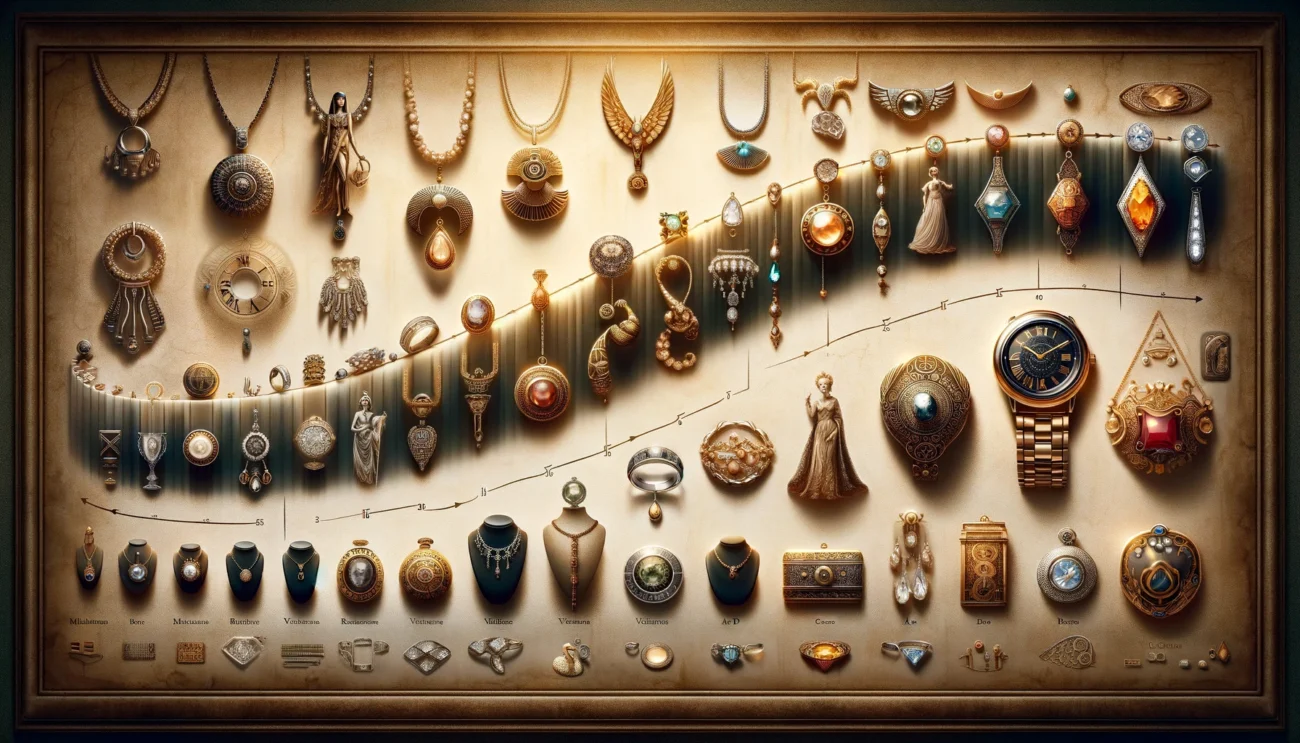Blog
The History of Bracelets: From Ancient Times to Modern Fashion
The History of Bracelets: From Ancient Times to Modern Fashion
Bracelets have been a significant part of human culture for thousands of years, evolving from simple adornments to sophisticated symbols of wealth, status, and personal expression. The history of bracelets is rich and diverse, spanning ancient civilizations and continuing to influence modern fashion trends. Throughout history, bracelets have been worn for various purposes, including religious, cultural, and aesthetic reasons.
In this article, we will explore the fascinating journey of bracelets, from their early beginnings in ancient times to their place in contemporary fashion. By understanding the history of bracelets, we can better appreciate their significance today.
1. The Origins of Bracelets: Ancient Civilizations
The use of bracelets dates back to ancient civilizations, where they were not only fashion statements but also carried symbolic meanings. Early bracelets were crafted from natural materials, such as bones, shells, stones, and wood, and were often used for protective or spiritual purposes.
Ancient Egypt: Symbolism and Spiritual Significance
In Ancient Egypt, bracelets were symbols of power, protection, and divine favor. Pharaohs and royalty wore elaborate bracelets made of gold, silver, and precious gemstones. The famous Egyptian scarab bracelet, often crafted from gold and adorned with symbols of rebirth, was thought to bring protection and good fortune. Bracelets in Egypt were also often inscribed with hieroglyphs that denoted the wearer’s social status or identity.
Jewelry in ancient Egypt was deeply intertwined with the beliefs of the afterlife. Egyptians believed that bracelets, along with other jewelry, played a crucial role in the spiritual world. Some bracelets were designed to protect the wearer from evil spirits, while others were buried with the deceased as part of the burial rituals.
Ancient Greece and Rome: Status and Beauty
In Ancient Greece and Rome, bracelets were worn by both men and women and were symbols of status and wealth. Greeks often wore intricate metal bracelets, typically crafted from bronze, silver, or gold, which were decorated with scenes of mythology and nature. Roman bracelets, known for their intricate craftsmanship, were often made from gold and silver and featured gemstones or cameos. Romans also began to experiment with different shapes and styles, such as the solid bangle, which became a popular form of bracelet.
The Romans viewed jewelry as a form of personal adornment and a way to display one’s wealth and social standing. As the empire expanded, jewelry, including bracelets, became more widely available, and different regions developed their own unique styles and techniques.
Ancient India: Spiritual and Decorative
In India, bracelets have been worn for thousands of years, both as ornamental jewelry and for their spiritual significance. Known as “kadas” or “bangles,” these bracelets were made from various materials, including gold, silver, glass, and even wood. In Indian culture, the wearing of bangles has long been a symbol of marriage and womanhood, particularly in Hindu traditions.
Brass and copper bracelets were also worn for their believed medicinal benefits. It was believed that these metals had the power to improve health, enhance energy, and bring good fortune. Many Indian bracelets were richly adorned with gemstones and intricate designs, showcasing the country’s advanced metalworking skills.
2. The Evolution of Bracelets in the Middle Ages and Renaissance
During the Middle Ages and Renaissance, the use of bracelets became more sophisticated and symbolic. While bracelets continued to be worn for personal adornment, they also became more deeply associated with personal wealth, social status, and religious beliefs.
The Middle Ages: Religious Symbolism
In the Middle Ages, Christianity played a dominant role in the lives of many people, and religious symbolism began to appear on jewelry. Christian bracelets often featured religious motifs, such as crosses or depictions of saints, and were used as symbols of faith and devotion. Pilgrims would wear bracelets made from materials like iron or wood as a sign of their journey to holy sites.
In addition to religious bracelets, the Middle Ages also saw the rise of the use of bracelets as symbols of chivalry and knighthood. Knights would wear bracelets to signify their rank and honor. Many of these medieval bracelets were engraved with symbols like coats of arms or other emblems to reflect the wearer’s noble status.
The Renaissance: Artistic Flourish
During the Renaissance, jewelry became more elaborate, and bracelets were no exception. The wealthy aristocracy of this period began to commission highly decorative and luxurious bracelets, often crafted from gold and adorned with diamonds, rubies, and other precious gemstones. These bracelets were intricately designed, reflecting the artistic innovations of the time.
Renaissance bracelets were often used as statement pieces, showcasing the wearer’s taste and social standing. They also became more delicate and refined in design, influenced by the period’s fascination with humanism, art, and beauty. The introduction of enamel work and colored gemstones also became prominent in bracelet designs during this period.
3. The Rise of Bracelets in Modern Fashion
The popularity of bracelets continued into the 19th and 20th centuries, evolving with changing fashion trends and technological advances in jewelry making. In the modern era, bracelets became more versatile, with different styles emerging to suit various tastes and occasions.
The Victorian Era: Sentimental Jewelry
In the Victorian era, bracelets gained popularity as sentimental pieces of jewelry. Queen Victoria, who reigned from 1837 to 1901, was known for her love of jewelry, and bracelets became a common part of her collection. Many of the bracelets from this period were made with lockets, which contained photographs or mementos of loved ones. These bracelets symbolized personal connections and sentimental value, often given as gifts for special occasions like engagements or anniversaries.
The Victorians were also known for their love of intricate designs, and many bracelets were adorned with detailed engravings, filigree work, and gemstones. The use of materials such as gold, silver, and enamel became popular during this period, leading to a wide variety of designs.
The 20th Century: The Birth of Modern Fashion Bracelets
The 20th century saw the rise of more experimental and innovative bracelet designs, influenced by various cultural movements, including Art Deco, Art Nouveau, and the rise of luxury fashion houses. Iconic brands like Cartier, Tiffany & Co., and Bulgari revolutionized the bracelet market, creating designs that became timeless symbols of luxury.
In the 1920s and 1930s, Art Deco bracelets became popular, featuring geometric patterns, bold colors, and the use of materials like platinum, diamonds, and onyx. During this time, bracelets became more streamlined, with a focus on clean lines and modern elegance.
The 1950s and 1960s brought a shift in fashion, with bracelets becoming more playful and colorful. Costume jewelry became widely popular, and designers like Coco Chanel popularized the idea of wearing bracelets as fashion statements rather than just symbols of wealth or status.
4. Bracelets in the 21st Century: Contemporary Styles and Innovations
Today, bracelets continue to evolve, with modern designs incorporating a blend of traditional craftsmanship and cutting-edge innovation. The diversity of materials used in bracelet making is greater than ever, with designs that range from minimalist and understated to bold and statement-making.
Customization and Personalization
In the 21st century, personalized and custom-made bracelets have become a major trend. Engraved bracelets, charm bracelets, and name bracelets allow individuals to express their personal style and create meaningful connections with their jewelry. With the advent of new technologies like 3D printing, it’s easier than ever to create unique, one-of-a-kind bracelets.
Fashion-Forward Bracelets
Contemporary fashion designers have taken bracelet designs to new heights. From stackable bangles to cuffs with intricate detailing, today’s bracelets are meant to be mixed and matched, allowing individuals to create personalized looks that express their style. Additionally, sustainable and eco-friendly materials, such as recycled metals and ethically sourced gemstones, are becoming increasingly popular, allowing people to wear jewelry that aligns with their values.
 Conclusion
Conclusion
From ancient Egypt and Greece to modern fashion, bracelets have played an essential role in human culture for thousands of years. They have evolved from symbols of protection and status to intricate pieces of art and self-expression. Today, bracelets continue to be cherished for their beauty, versatility, and significance, making them an essential accessory in the world of fashion.
As we look back on the history of bracelets, we can appreciate the many ways these timeless pieces of jewelry have adapted to the changing needs and desires of society. Whether simple or extravagant, classic or contemporary, bracelets will undoubtedly remain a beloved part of jewelry collections for years to come.



